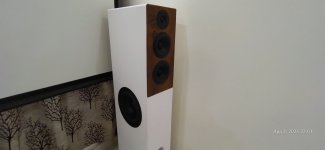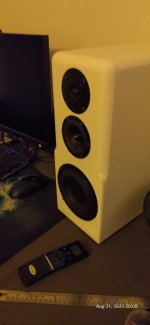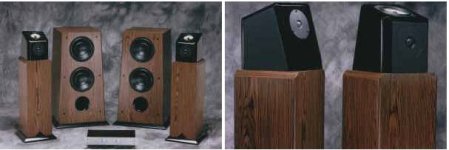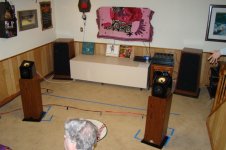I think it's very unusual for "regular" stereo hifi speakers to have the option and connections for biamping. There are several reason biamping wasn't as popular decades ago. Surely one was audio power amplifiers were relatively more expensive than now, and having twice the number of channels was usually deemed too costly. I think by the 1990s things changed (reasonably good chip-amps like the LM3886 came out, and electronics in general became less expensive) and a lot of powered PA speakers, pro and "semi-pro" studio monitors appeared on the market. These are fully enclosed biamp systems with amplifiers and speaker drivers, and basically two inputs: line-level signal, and 120/240v power.
Rod Elliott has a fairly long and gushing article on biamping (it also mentions bi-wiring, a separate-but-related thing, and I wonder if that's part of the reason for the OP's extra speaker connections), listing many advantages:
https://sound-au.com/bi-amp.htm
Rod Elliott has a fairly long and gushing article on biamping (it also mentions bi-wiring, a separate-but-related thing, and I wonder if that's part of the reason for the OP's extra speaker connections), listing many advantages:
https://sound-au.com/bi-amp.htm
I am bi-amping using the PLLXO I built about five or so years ago.
I use two SMSL SA-160 amplifiers, each with a dedicated MEAN WELL power supply.
I'm using DIY speakers. Satellites are small boxes with Faital 3FE22 full-range drivers, woofers are a stereo pair of GRS-12SW.
Going with the PLLXO and two amps is probably would what I'd have spent on decent passive speaker-lever crossover components, and I think bi-amping is perhaps a little more fool-proof to implement (designing passive crossovers that work well/sound good can require some trial and error, and that can get sort of expensive at lower frequencies like 300-Hz).

I'm actually gearing-up to make a newer version of this with what I've learned while building my own phono preamp. I've gotten better at board design (I'm using a CNC router to make my own boards).
I use two SMSL SA-160 amplifiers, each with a dedicated MEAN WELL power supply.
I'm using DIY speakers. Satellites are small boxes with Faital 3FE22 full-range drivers, woofers are a stereo pair of GRS-12SW.
Going with the PLLXO and two amps is probably would what I'd have spent on decent passive speaker-lever crossover components, and I think bi-amping is perhaps a little more fool-proof to implement (designing passive crossovers that work well/sound good can require some trial and error, and that can get sort of expensive at lower frequencies like 300-Hz).
I'm actually gearing-up to make a newer version of this with what I've learned while building my own phono preamp. I've gotten better at board design (I'm using a CNC router to make my own boards).
A lot more stuff in yours. This is one of mine:

dave
dave
Who says ChatGPT is right?When is ChatGPT going to get an account on DIYAudio? 🙂
1st order low pass, 2nd order high pass?
I take it the inductors are iron core and very very skinny wire?
I take it the inductors are iron core and very very skinny wire?
Well I count two more resistors and a PCB for mine. But with such low parts counts to start, that may be 30% more parts. 🙂
I made a phono preamp and learned quite a bit, which I plan to apply to my next PLLXO.
I'm using a bi-amp setup with a twin pair of Dynaco/VTA tube amps used as mono blocks on the mids/tweeters, and a Kenwood integrated amp with active crossover at 80hz and below (along with an active subwoofer). Very, very pleased with that scenario. It sounds very clear, and gives me a lot of flexibility with bass adjustments. At some point, I'd like to add a high pass filter in front of the tube amps to keep the bottom octave or two out of the input.
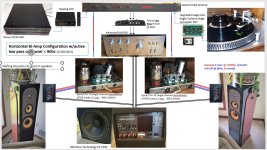

and a Kenwood integrated amp with active crossover at 80hz and below
An excellent example of using almost anything you can grab to drive the helper woofers.
dave
is this a passive crossover ? before the amp ?. first order? I built a two way and I need to cross them at 200hz and passive speaker crossover would require huge inductors. Dayton TC115 and PS95's . Also I was thinking about bi-amping them but I don't know first order, 2nd order, 3rd order ? I found this one on Rod elliott's https://sound-au.com/project123.htm
Last edited by a moderator:
I recently upgraded from my PLLXO to a MiniDSP 2x4HD. I use the MiniDSP's DAC, fed via Toslink from my streaming PC (a Raspberry Pi-4 running piCorePlayer). I'd have done this sooner but read reports of noise (hiss) and was worried about adding noise. I was very happy to discover that any hiss is so slight that I need to get within a foot of my full-range drivers to hear it. I do see how hiss could be a problem for users with noiser amps w/o any gain adjustment, combined with high efficiency horn-loaded HF drivers. Luckily for me, though, not an issue.
The ability to adjust everything is great. And four presets that I can toggle through from the remote allowed me to fine-tune the driver levels quickly, it was actually quite enjoyable.
The ability to adjust everything is great. And four presets that I can toggle through from the remote allowed me to fine-tune the driver levels quickly, it was actually quite enjoyable.
Rod Elliott's Linkwitz-Riley based active crossover is EXCELLENT.
Absolutely still bi-amping. Pass Labs XP-30, to McCormack DNA-500 (woofers) and to McCormack DNA-750 monos (mids and tweeters) to Legacy Focus SE speakers. The Pass preamp is a 3 piece preamp and allows for 2 simultaneous outputs - 1 fixed volume master output and 1 variable volume slave output. So this makes it easy to adjust one of the outputs to match the other for the different amps that you might be using.
This is a great set up for me as the McCormack DNA-500 is a killer bass amp! And the McCormack DNA-750 monos were actually made by Conrad Johnson and have the super nice Conrad capacitors in them and they are perfect and smooth for the top end.

This is a great set up for me as the McCormack DNA-500 is a killer bass amp! And the McCormack DNA-750 monos were actually made by Conrad Johnson and have the super nice Conrad capacitors in them and they are perfect and smooth for the top end.
is this a passive crossover ? before the amp ?. first order?
Yes. Yes. That one was first order LP, 2nd order HP. We designed for first order HP after that one.
For stereo requires 4 small Cs and 2 Rs.
The lowest we have tried passive speaker level is 250 Hz, and parts are huge.
dave
Quad-amping here, 2x500W class D (plate amps in subs), 2 x 60W Icepower class D running woofers (98dB), 2 x 6.5W running mid-range horns (110dB), 2 x 6.5W running horn tweeters. (110dB).
Crossovers are handled by a Danley DNA SC-48 (AKA Linea Research ASC-48) Digital front end is a MiniDSP SHD Studio. Primary source is a Roon streamer, secondary are analog sources through an RME ADI-2 PRO FS R BE.
Previously I used 4th order LR active 3-way line level crossovers of my own design. I much prefer the SC-48 both subjectively and for the great flexibility it provides.
No going back. 😀
Crossovers are handled by a Danley DNA SC-48 (AKA Linea Research ASC-48) Digital front end is a MiniDSP SHD Studio. Primary source is a Roon streamer, secondary are analog sources through an RME ADI-2 PRO FS R BE.
Previously I used 4th order LR active 3-way line level crossovers of my own design. I much prefer the SC-48 both subjectively and for the great flexibility it provides.
No going back. 😀
I see I commented in this thread a year ago, but reading through again, I feel the need to say this: Every time you see DSP in relation to a multi-way speaker system, that means it's bi-amped, tri-amped or quad-amped. I've seen a lot of DSP threads in the multi-way forum over the years, it's either very fiddly and prompts a lot of questions and answers (quite possible) or a LOT of people are doing "DSP-level" crossovers these days (very likely, it seems). So yes, "bi-amping" is surely more popular than ever, even if it's not called that. If there's anything in danger of going out of style, it's probably the analog line-level "active crossover" previously used in virtually all bi-amped systems.The word 'still' is offensive in the title of this thread 🙂
- Home
- Amplifiers
- Solid State
- Is anyone still using bi-amping?
